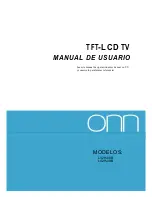
Service Modes, Error Codes, and Fault Finding
5.
5.3
i-Board and LCD Clock
5.3.1
General
Circuit diagram HC (chapter 7) shows the schematic diagram
of the i-Board together with IO for LC4.xHx. The main
microprocessor is the P89C664, a 64K flash microprocessor
from Philips. In some sets on the market, the P89C668 (96K)
microprocessor is used. There are 3 HEF switches (U2, U3,
U4) which select the different interface control protocols to
work with the external service providers. U7 is a RS232 IC.
The iTV i-Board is constantly powered by 5V, even when the
TV set is in its Stand-by mode or switched off by using the
power button on the local keyboard. The constant power supply
enables the i-Board to communicate constantly with the head-
end server of the service provider. In this chassis, only 3V3 is
available and this is converted to 5V.
5.3.2
Checking the i-Board
1.
Check the voltages across C1 (= 3V3) and C4 (= 5V).
If these are correct, the 3V3 to 5V converter is working
properly.
2.
Check the clock signal on pin 2 (SCL), and data line pin 3
(SDA) of the i-Board microprocessor P89C664 with an
oscilloscope. If the communication between the
microprocessor P89C664 and the TV scaler board is
working correctly, the iTV OSD menu will appear when the
menu button on the setup remote control is activated.
3.
Check pin 4 of the microprocessor P89C664, it should be
low when the microprocessor is operating normally. Pin 4
goes to the “high” state and causes the microprocessor to
“hang” if the supply voltage drops below 4.5 - 4.75V. U6 is
used to reset the microprocessor and to monitor the supply
voltage.
4.
Check (using an oscilloscope) if the sine wave (16 MHz) is
present on pin 14 and 15 of the microprocessor P98C664
(internal Xtal oscillator).
5.3.3
Checking the LCD Clock
1.
If the LCD clock is not working correctly, first check the
error status of the clock module. In the iTV mode, press the
RECALL button on the iTV remote control in order to show
the status of the clock module.
2.
If the LCD clock is not displaying the correct time, check if
there is a Teletext signal available (some TV programs do
not carry Teletext information).
Note:
The LCD clock is connected directly to the i-Board
microprocessor P89C664. All Local Time information
downloaded via Teletext is captured by the Hercules IC on
the main board, relayed to the i-Board microprocessor
P89C664 and displayed via the LCD clock module. The
LCD clock itself does not keep track of real time.









































